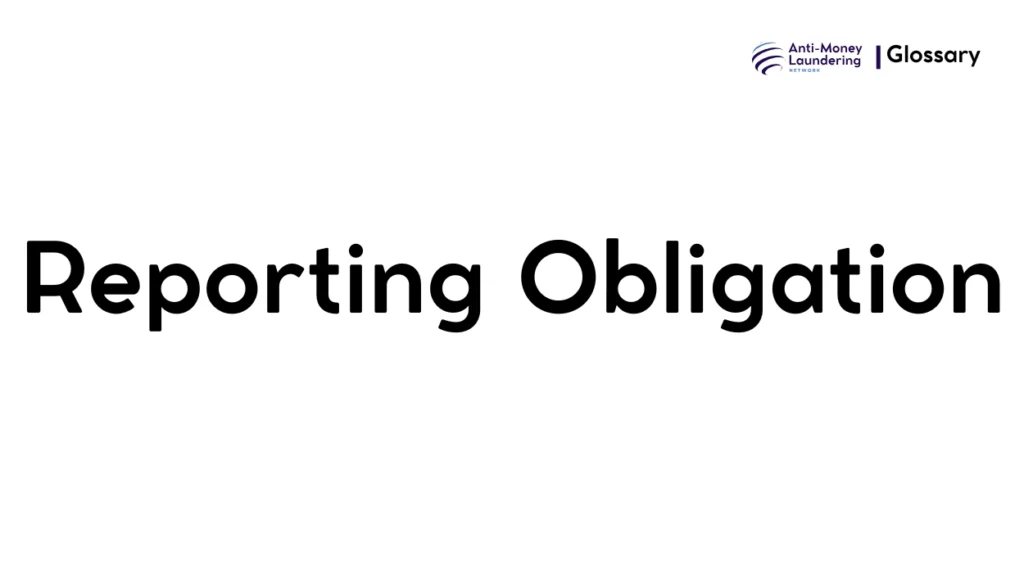Understanding Reporting Obligation within Anti-Money Laundering (AML) compliance is vital for compliance officers and financial institutions tasked with safeguarding the integrity of financial systems. This comprehensive guide explores its definition, purpose, applications, procedural requirements, challenges, and recent developments to provide a clear and professional overview suitable for AML professionals.
Definition
Reporting Obligation in AML refers to the mandatory legal requirements imposed on financial institutions and regulated entities to identify, document, and report suspicious transactions or activities that may indicate money laundering, terrorist financing, or other illicit financial crimes to designated regulatory authorities in a timely manner. It serves as a crucial mechanism for the detection, investigation, and prevention of financial crimes.
Purpose and Regulatory Basis
Reporting obligations play a central role in the AML framework by enabling authorities to uncover and disrupt criminal financial activities. They ensure transparency, support law enforcement investigations, and help maintain trust and stability in the financial system.
Key Global and National Regulations:
- Financial Action Task Force (FATF): Sets international AML standards, recommending member countries implement robust reporting mechanisms.
- USA PATRIOT Act (2001): Expands reporting duties for U.S. financial institutions, including Suspicious Activity Reports (SARs) to FinCEN.
- European Union AML Directives (AMLD): Mandates reporting requirements across member states, including thresholds for reports on transactions and suspicious activities.
These regulations require institutions to establish policies and controls that ensure suspicious or threshold transactions are reported accurately and promptly to regulatory bodies.
When and How it Applies
Reporting obligations typically trigger when an institution detects:
- Suspicious Activities: Unusual transaction patterns, inconsistent customer information, or behaviors indicative of money laundering or fraud.
- Specified Threshold Transactions: Such as cash transactions exceeding legally defined amounts (e.g., $10,000 in the U.S.).
- Sanctions Matches: Transactions involving parties on sanctions lists.
Examples:
- Filing a SAR after noticing structured transactions designed to evade reporting thresholds.
- Submitting Currency Transaction Reports (CTRs) for large cash deposits.
- Reporting cross-border transfers above defined limits.
These reports ensure that potential illicit activities are brought quickly to regulatory attention.
Types or Variants
1. Suspicious Activity Reports (SARs)
Filed when transactions or activity raise suspicion of illegal conduct.
2. Currency Transaction Reports (CTRs)
Mandatory reports for cash transactions exceeding specific thresholds regardless of suspicion.
3. Sanctions Reporting
Filed when transactions involve sanctioned entities or countries.
4. Cross-Border Transfer Reports
Reporting of international funds transfers exceeding thresholds, often mandated by the “Travel Rule.”
Procedures and Implementation
To comply with reporting obligations, financial institutions must:
- Implement Monitoring Systems: Automated transaction monitoring to detect suspicious patterns and alert compliance teams.
- Customer Due Diligence (CDD): Collect and verify accurate customer information.
- Internal Controls: Establish procedures for escalation, investigation, and documentation of suspicious transactions.
- Filing Reports: Submit required reports (SARs, CTRs) within regulatory deadlines using prescribed formats.
- Training and Awareness: Regular AML training for staff to recognize suspicious activities and understand reporting duties.
Use of technology, such as AML software platforms, can automate alert generation and improve report accuracy and timeliness.
Impact on Customers/Clients
From the customer perspective, reporting obligations may result in:
- Enhanced Scrutiny: More rigorous verification and monitoring of transactions.
- Privacy Considerations: Assurance that reports respect confidentiality laws, but also possible disclosures if investigations ensue.
- Service Delays: Occasional transaction holds during compliance reviews.
Customers have rights under data protection and AML laws but must comply with due diligence requirements.
Duration, Review, and Resolution
After a report is filed:
- Institutions must retain records supporting the report for statutory periods (often 5+ years).
- Compliance teams conduct ongoing reviews of flagged activities.
- Authorities investigate reported cases; institutions may provide further information.
- Reporting obligations are continuous, requiring real-time vigilance and periodic compliance audits.
Reporting and Compliance Duties
Institutions bear responsibility to:
- Maintain documented AML policies incorporating reporting protocols.
- Ensure timely and complete report submissions.
- Collaborate with regulators and law enforcement.
- Implement robust recordkeeping to demonstrate compliance during audits.
- Face potential penalties, including fines and reputational damage, for failure to fulfill reporting duties.
Related AML Terms
Reporting Obligation connects closely with:
- Know Your Customer (KYC): Gathering customer data to enable effective monitoring.
- Transaction Monitoring: The process generating triggers for reports.
- Customer Due Diligence (CDD): Foundation for assessing risks.
- Suspicious Activity Reports (SARs): Primary vehicle to fulfill reporting obligations.
- Regulatory Authorities: Recipients of mandatory reports.
Challenges and Best Practices
Challenges:
- Managing high volumes of alerts leading to “alert fatigue.”
- Ensuring accuracy and timeliness of reports.
- Navigating complex, varying regulations across jurisdictions.
- Balancing customer privacy with regulatory transparency.
Best Practices:
- Utilize advanced analytics and automation to prioritize significant alerts.
- Develop clear escalation pathways and internal audit functions.
- Stay updated with global AML regulatory changes.
- Foster a strong compliance culture through leadership commitment and training.
Recent Developments
- Technology Integration: Increasing adoption of AI and machine learning for anomaly detection and reporting.
- Global Harmonization: Efforts by FATF and others to standardize reporting requirements.
- Expanded Scope: Growing coverage of virtual assets and non-traditional financial entities.
- Regulatory Updates: Stricter deadlines and expanded reporting categories, emphasizing timely information sharing and cross-border cooperation.
Reporting Obligation is a cornerstone of AML frameworks, mandating financial institutions to promptly identify and report suspicious or threshold financial activities. This duty supports the global fight against financial crime, requiring robust systems, policies, and vigilant staff. Adherence protects institutions from legal risks and contributes to maintaining a secure and transparent financial system.

